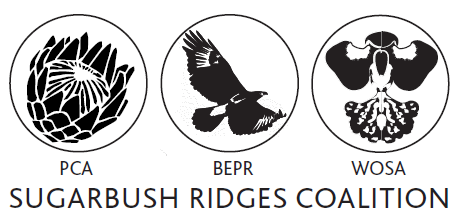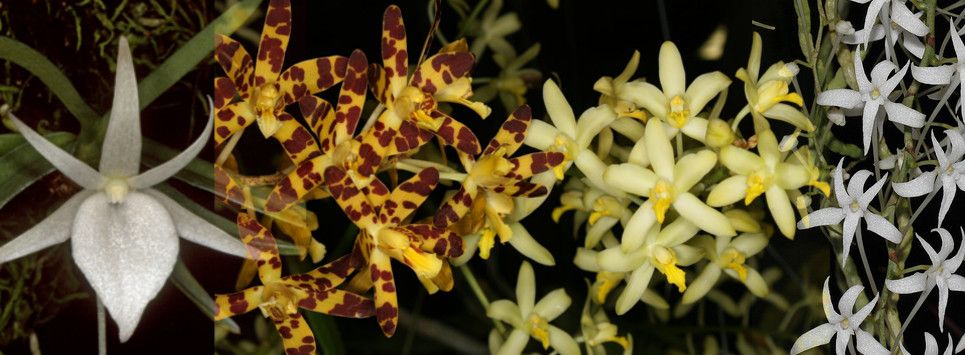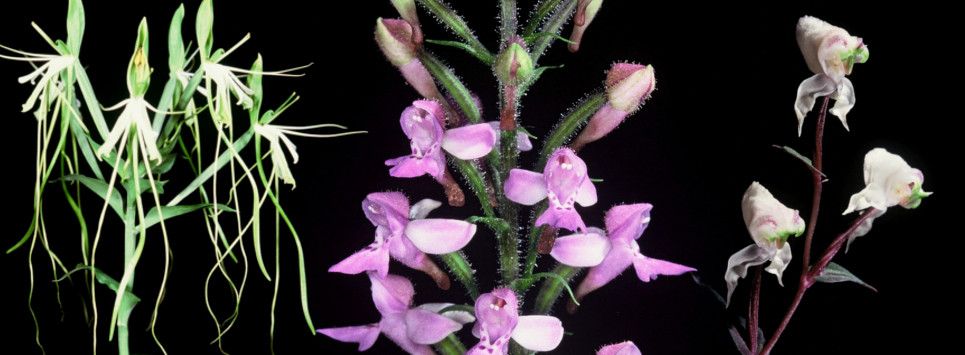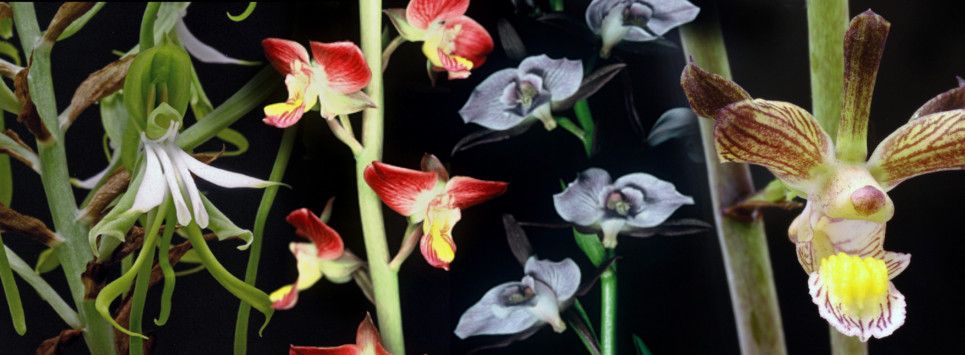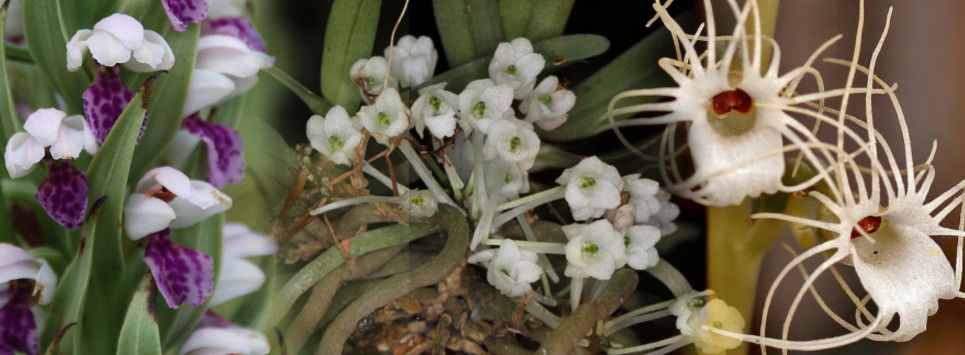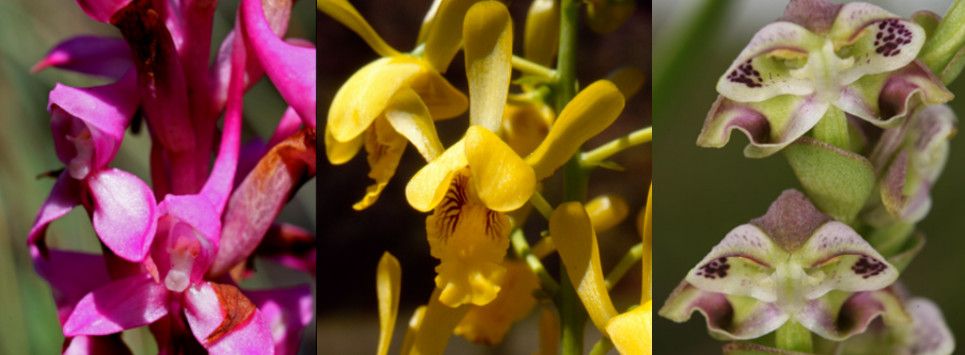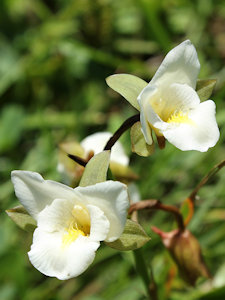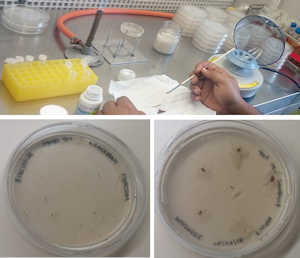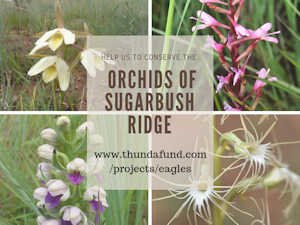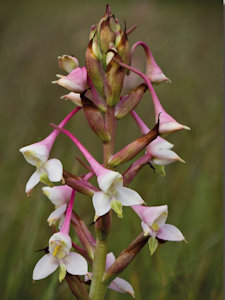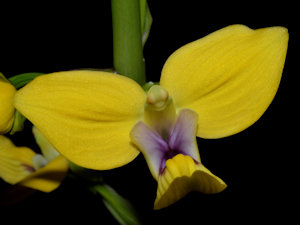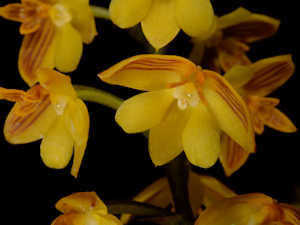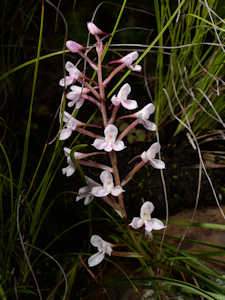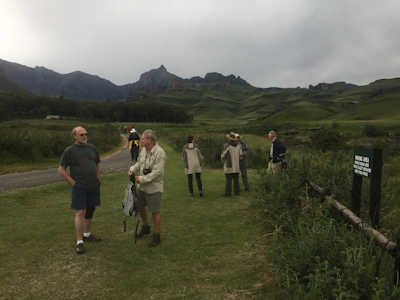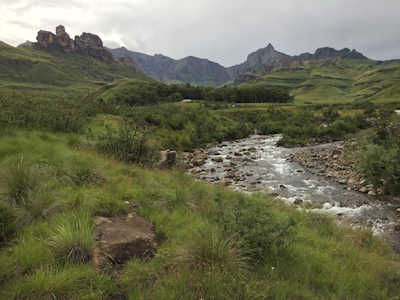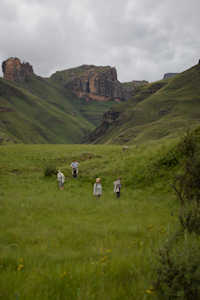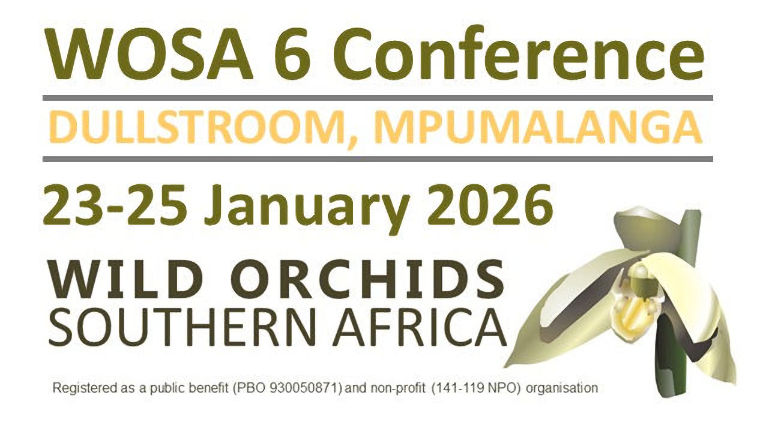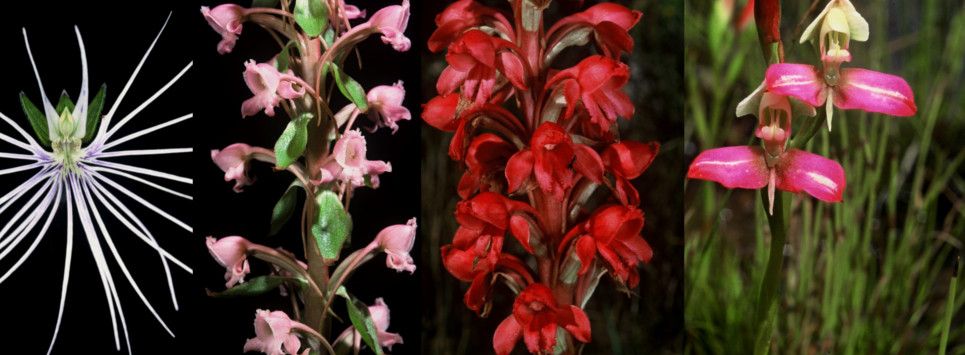
Welcome to WOSA
Very little is known about indigenous orchids by the public who are largely unaware that there are just under 500 species of which 45 are endemic (only occur in South Africa). Very little research has been carried out regarding ecology, conservation and propagation although a number of species have become extinct and habitat destruction is progressing at an alarming rate. Up until now there has been no attempt to address these issues on a National scale and Provincial legislation and cooperation is fragmented. Only through a focused National integrated effort that engages the public and all roll players will survival of orchids be assured.
Proceedings WOSA 3 Conference 2018

Andrew Hankey(Speaker), Karsten Wodrich(Speaker), Prof. Steve Johnson(Speaker), Marinus Kort(Audiovisual)
Prof.Joanna Dames(Speaker), Tanay Bose(Speaker) Prof. Craig Peter(Speaker), Marco Balducci(Speaker), Modjadji Makwela(Speaker)
Not Present Lourens Grobler(Speaker), Tinus Oberholzer(Speaker), Suvarna Parbhoo(Speaker), Lance Rasmussen(Speaker), Dr. Peter Ashton(Speaker)
Index
- Opening address
- Natural hybridisation of orchids in South Africa, Evidence and patterns
- Propagating indigenous orchids
- The genus Ansellia
- Evaluating the horticultural potential of African orchids
- Night and days specialised and diverse forms of Lepidoptera pollination in the orchid Bonatea
- Citizen scientists surveying South African orchids of conservation concern – CREW
- Demystifying orchid mycorrhiza interactions
- Part 1 Diversity of Mycorrhiza with endemic South African orchids Habenaria Barbertoni
- Part 2 Diversity of Mycorrhiza with endemic South African orchids Habenaria Barbertoni
- Malawi’s mountainous areas are critically important refuges
- Community-based initiatives for the conservation of the Krugersdorp ridges and the Albertina Sisulu orchid
- What pollination and reproductive biology can tell us about the rarity of the Albertina Sisulu orchid, Brachycorythis Conica Transvaalensis
- Albertina Sisulu orchid workshop
- Field trips
1. Opening address
WOSA chairman Bill Mincher
 Bill Mincher enjoys the outdoors and served many years with FOSAF the Federation of Southern African Fly Fishers. During this time he was instrumental in creating the successful Yellowfish Working Group (YWG) which is cited as one of the greatest success stories in angler-driven conservation ever achieved in South Africa. Together with enthusiasts from the three Gauteng Orchid Societies of Witwatersrand Orchid Society, North Gauteng Orchid Society and East Rand Orchid Society, they formed Wild Orchids Southern Africa (WOSA), based on the principals of the YWG. WOSA is now going National with support from the other regions gaining momentum.
Bill Mincher enjoys the outdoors and served many years with FOSAF the Federation of Southern African Fly Fishers. During this time he was instrumental in creating the successful Yellowfish Working Group (YWG) which is cited as one of the greatest success stories in angler-driven conservation ever achieved in South Africa. Together with enthusiasts from the three Gauteng Orchid Societies of Witwatersrand Orchid Society, North Gauteng Orchid Society and East Rand Orchid Society, they formed Wild Orchids Southern Africa (WOSA), based on the principals of the YWG. WOSA is now going National with support from the other regions gaining momentum.
Welcome
It gives me great pleasure to welcome you to our Third National Conference. Since the launch of WOSA at the 21st World Orchid Conference a lot has happened although it seems like only yesterday. We have registered as a Non-Profit Organisation and a Public Benefit Organisation which allows us to issue certificates for donations and tax relief for the donors. We have received two important donations one from Mark Shuttleworth for the launch of WOSA and creation of the Wetland at 21st World Orchid Conference. The other was a donation from Nicky and Strillie Oppenheimer for the printing of the Flowers of Verloren Valei Guide and they also assisted the Proteadal Conservation Association with initial funding for the Albertina Sisulu Orchid court case.
Download the pdf Chairmans-Address-B.Mincher-WOSA3-2018.pdf
2. Natural hybridisation of orchids in South Africa, Evidence and patterns
Prof. Steve Johnson
 Professor Steven Johnson’s research focuses on pollination biology, evolution, plant speciation, insect-plant relationships, and floral deception and mimicry.
Professor Steven Johnson’s research focuses on pollination biology, evolution, plant speciation, insect-plant relationships, and floral deception and mimicry.
He obtained a B.Sc. (Hons.) and Ph.D. in Botany from the University of Cape Town in 1994. He then worked as a post-doctoral researcher at the University of Haifa in Israel and at Uppsala University in Sweden before moving to UCT where he was a Smuts Post-doctoral Fellow. He is currently a full Professor at the University of KwaZulu-Natal, and holds the DST/NRF South African Research Chair in Evolutionary Biology. During the course of his career he has published or co-published more than 270 peer-reviewed scientific papers and book chapters, as well as four books: Table Mountain: a Natural History (1999), Cape Orchids (2012), Orchids of South Africa (2015) and Floral Mimicry (2017). He has served on the editorial boards of Oecologia, Arthropod-Plant Interactions, and Proceedings of the Royal Society: Biological Sciences and has acted as a reviewer for numerous other journals. He started working at Verloren Vallei in the mid 1990s.
Abstract
Natural hybridization is an important evolutionary process that can act as a bridge for gene flow between species, generate new variation, and even precipitate formation of new species. Orchids are an ideal plant group for assessing the incidence of natural hybridization as they are well-studied and form hybrids that are relatively easy to identify using floral traits. Here I provide an illustrated compendium of the putative natural orchid hybrids recorded in South Africa and ask whether natural hybridization is concentrated in particular lineages or floristic regions. There are 0.082 reported natural hybrids for every orchid species in South Africa, which is similar to the value of 0.09 reported for angiosperms in general. The largest number of putative natural hybrids is found in Disa (17 hybrid combinations involving 25 species) and Satyrium (11 hybrid combinations involving 13 species). The weighted average hybridization propensity (percentage of possible hybrid combinations realized) for South African orchids is estimated to be 0.92%, which is much lower than the value of 6% reported for orchids in seven other mainly temperate northern hemisphere floras. Natural hybridization appears to be more frequent in the Cape Floristic Region (documented for 15% of orchid species) than in the rest of South Africa (documented for 8% of orchid species). The factors that govern variation in the frequency of natural hybridization among orchid species are still largely unknown and require further investigation.
The full paper is available for purchase from ScienceDirect
3. Propagating indigenous orchids
Karsten Wodrich
 Karsten has been growing orchids since he was 14 when he first found a colony of Eulophia ovalis ssp. bainesii in Robindale, Randburg. Whilst studying to become a Mechanical Engineer at the University of Stellenbosch he published a book entitled Growing South African Indigenous Orchids in 1996. After leaving university Karsten stared both a family and a business, and orchids had to take a back seat. Now that both those undertakings have become firmly established he has returned to his love of orchids and is concentrating on propagating species and hybrids from seed. He is currently Vice-Chairman of WOSA. The propagation lab is currently housed in an outbuilding cottage which is also used for visitors that stay for a while. Before the visitors arrive, the complete lab needs to be re-located to various other parts of the house including a Wendy-house. This is now done well in advance after an experience where the visitors came back into the house for breakfast after the first night and shyly asked why the cottage had this peculiar hospital smell to it. It turned out to be the smell of the sterilising solution used to sterilise the laminar flow and surfaces that was still lingering.
Karsten has been growing orchids since he was 14 when he first found a colony of Eulophia ovalis ssp. bainesii in Robindale, Randburg. Whilst studying to become a Mechanical Engineer at the University of Stellenbosch he published a book entitled Growing South African Indigenous Orchids in 1996. After leaving university Karsten stared both a family and a business, and orchids had to take a back seat. Now that both those undertakings have become firmly established he has returned to his love of orchids and is concentrating on propagating species and hybrids from seed. He is currently Vice-Chairman of WOSA. The propagation lab is currently housed in an outbuilding cottage which is also used for visitors that stay for a while. Before the visitors arrive, the complete lab needs to be re-located to various other parts of the house including a Wendy-house. This is now done well in advance after an experience where the visitors came back into the house for breakfast after the first night and shyly asked why the cottage had this peculiar hospital smell to it. It turned out to be the smell of the sterilising solution used to sterilise the laminar flow and surfaces that was still lingering.
Abstract
Propagating South African indigenous orchids comes with its own set of unique problems. Initially, very little data was available on how to grow specific species and genera from seed. Further challenges involve obtaining viable seed, sterilising the seed to obtain contamination-free cultures and then finally de-flasking the plants and getting them to mature, grow and flower successfully.
The presentation is a summary of the work done in the last 30 years on the in-vitro and ex-vitro propagation of indigenous orchids and focuses on some of the pitfalls and successes achieved.
Download the full paper Propagation-of-Indigenous-orchids-K.Wodrich-WOSA3-2018.pdf
4. The genus Ansellia
Lourens Grobler

Abstract
The Genus Ansellia consists of one species, Ansellia africana. There are many arguments for more species to be recognised and this will be discussed. I will have a look at the line breeding of the species as well as growing them successfully. I will also discuss the conservation status of the genus, especially in South Africa
5. Evaluating the horticultural potential of African orchids
Tinus Oberholzer
 My love for orchids started in high school when I bought my first plant, which, I am pleased to say, is still alive. I matriculated from an Agricultural high school, studied horticulture at the Pretoria Technikon and received my B-Tech degree in 2007. After being employed as a senior horticulturist for some years, I eventually decided it was time to do my own thing. Together with Nollie Cilliers, we started Plantae Orchids, an orchid and rare plant nursery. We strive to supply the local market with the latest hybrids and also sought-after species. As a member the Orchid Society of Northern Transvaal, I soon realized I wanted to become an orchid judge. I qualified in 2008 as a judge with the South African Orchid Council and currently serve on the SAOC board as president. I was the show chairman of the 15th National SAOC Orchid Show hosted by the Rustenburg Orchid Society which is now my home society. September 2013 saw the release of ‘Anyone can grow orchids’ - a book authored by Nollie Cilliers and myself. We expect it to act as a guide for South African orchid growers and gardeners. This book as well as talks at orchid societies, garden clubs and conferences is my way of sharing a love for orchids with like- minded people. I love seeing orchids grow in nature and we take every available opportunity to go and search for orchids in the natural habitat.
My love for orchids started in high school when I bought my first plant, which, I am pleased to say, is still alive. I matriculated from an Agricultural high school, studied horticulture at the Pretoria Technikon and received my B-Tech degree in 2007. After being employed as a senior horticulturist for some years, I eventually decided it was time to do my own thing. Together with Nollie Cilliers, we started Plantae Orchids, an orchid and rare plant nursery. We strive to supply the local market with the latest hybrids and also sought-after species. As a member the Orchid Society of Northern Transvaal, I soon realized I wanted to become an orchid judge. I qualified in 2008 as a judge with the South African Orchid Council and currently serve on the SAOC board as president. I was the show chairman of the 15th National SAOC Orchid Show hosted by the Rustenburg Orchid Society which is now my home society. September 2013 saw the release of ‘Anyone can grow orchids’ - a book authored by Nollie Cilliers and myself. We expect it to act as a guide for South African orchid growers and gardeners. This book as well as talks at orchid societies, garden clubs and conferences is my way of sharing a love for orchids with like- minded people. I love seeing orchids grow in nature and we take every available opportunity to go and search for orchids in the natural habitat.
Abstract
Africa is known for the vast open plains which contain the big five, the great migration of wildebeest and zebra as well as the great varied range of wonderful indigenous flora. The Cape floral kingdom is one of the regions with such great diversity. There is, however, a wondrous variety of orchids which can be found on the continent and its surrounding islands. These are perhaps less known. Arguably, the best known South African orchid is Disa uniflora while Angraecum sesquipedale is surely the Madagascan species with which people are most familiar. In the horticultural world, plants from Africa have made a huge contribution. A myriad of species and hybrids with their roots in Africa are known all over the world and produced in their millions to be sold for the use of gardeners and the cut flower trade. We must only think of plants such as Proteas, Perennial and annual plants such as Nemesias, Diascias, Osteospermum, Pelargonium etc; then there are those used as indoor plants in the colder regions or landscape plants in warmer regions, e.g. Clivia, Strelitzia, Asparagus, Dracaenea and the list goes on. Bulbous plants such as Zantedeschia, Ixia, Freesia, Ornithogalum and many others are known and used all over the world. The horticultural value of these plants is undeniable, but can the same be said about the orchid species occurring in our region and the hybrids derived from them? African and Madagascan orchid species and their hybrids are in high demand with orchid collectors in most parts of the world. As far as the species are concerned, the rarer the better or the more bizarre, the higher the demand. This applies especially to orchid collectors and these plants are then sold in various different sizes. They are seldom in flower as people are just too happy to get a plant so they do not mind what size it is. Getting these to flower in their own collection is part of the thrill. But the big question is: Can these plants compete with the pot plant orchids of the world? Do they have it in them to make it through the stringent evaluation most reputable pot plant producers have before taking on a new line into production? Firstly we must clarify what we will define as a plant having horticultural potential. Then we will look at the various trial stages and selection criteria pot plant growers use when it comes to mass production of plants. We will consider the numbers which make a horticultural line viable Then we move on to some species, selected forms/varieties and some of the current hybrids to evaluate their potential, weigh up the pros and cons and suggest a way forward.
Download the full paper Evaluating-the-horticultural-potential-African-orchids-T.Oberholzer-WOSA3-2018.pdf
6. Night and days specialised and diverse forms of Lepidoptera pollination in the orchid Bonatea
Marco Balducci
 Marco is fairly new to the orchid scene having previously done an honours degree in invasion biology at the University of Pretoria. Having grown a particular interest in plant-pollinator interactions during his time at TUKS, he proceeded to join up with Professor Steven Johnson and Dr Timo van der Niet at the University of KwaZulu-Natal. His master's research primarily involves unravelling the pollination biology of the fairly unknown terrestrial orchid genus Bonatea. Marco hasn’t looked back since joining the pollination lab in 2016 and has indulged in this interesting and widespread orchid genus, leading him to travel through most parts of South Africa and even warranted a short trip to Kenya.
Marco is fairly new to the orchid scene having previously done an honours degree in invasion biology at the University of Pretoria. Having grown a particular interest in plant-pollinator interactions during his time at TUKS, he proceeded to join up with Professor Steven Johnson and Dr Timo van der Niet at the University of KwaZulu-Natal. His master's research primarily involves unravelling the pollination biology of the fairly unknown terrestrial orchid genus Bonatea. Marco hasn’t looked back since joining the pollination lab in 2016 and has indulged in this interesting and widespread orchid genus, leading him to travel through most parts of South Africa and even warranted a short trip to Kenya.
Abstract
The terrestrial orchid genus Bonatea Wild. includes 13 species and is distributed along, and confined to the eastern seaboard of southern and east Africa, occurring in the grassland, savannah and forest biome. Flowers are typically green and white, strongly scented with a single nectariferous spur. The genus is characterised by extensive basal fusion of the sepals, petals and stigmatic arms with the presence of a perianth tooth in the spur mouth. Here we document several recently discovered pollination systems through direct observation, photography, and motion triggered cameras. Field studies in southern and east Africa showed that flowers of B. antennifera, B. polypodantha, B speciosa and B. steudneri are pollinated exclusively by hawkmoths. These species are characterized by traits such as crepuscular scent emission, pale white-green lower petal/labellum lobes (often threadlike) and long spurred flowers with large volumes of dilute nectar. Bonatea cassidea was visited exclusively diurnally by butterflies. It differs from all other species in diurnal scent, mostly white-coloured flowers with shorter spurs and lower nectar volume. We conclude that floral variation is mainly associated with divergent use of the same pollinators, although differences in scent/colour also play a role in determining specialized nocturnal versus diurnal Lepidopteran pollination.
7. Citizen scientists surveying South African orchids of conservation concern – CREW
Suvarna Parbhoo
 Having progressed in the field of threatened plant conservation since 2006, I capacitate a network of volunteers from a range of socio-economic backgrounds to survey and conserve South Africa’s plants of conservation concern. I am inspired by creating opportunities for and engaging with students to partake in the sector. I mentor several individuals as they take on internships and progress into the workforce. Determined to increase Human Capital Development within the botanical sector, I engage with 3rd year Botany, Environmental Science, Nature Conservation and Horticulture students at several universities in KwaZulu-Natal, Gauteng, Limpopo and Free State provinces. Apart from my leadership role within the CREW programme, I am the Chair of the Botanical Society KZN Coastal Branch, where I actively support the activities of plant conservation. I serve as Vice-Chair of the Durban Inner-City Faith-Based Conservancy to support the eThekwini Municipality in their efforts to create a greener, healthier, more livable environment in the Durban Inner City. Also, I organize the Botany session at the annual Symposium of Contemporary Conservation Practice to ensure Botany is a prominent theme at the conference as well as on the student award committee.
Having progressed in the field of threatened plant conservation since 2006, I capacitate a network of volunteers from a range of socio-economic backgrounds to survey and conserve South Africa’s plants of conservation concern. I am inspired by creating opportunities for and engaging with students to partake in the sector. I mentor several individuals as they take on internships and progress into the workforce. Determined to increase Human Capital Development within the botanical sector, I engage with 3rd year Botany, Environmental Science, Nature Conservation and Horticulture students at several universities in KwaZulu-Natal, Gauteng, Limpopo and Free State provinces. Apart from my leadership role within the CREW programme, I am the Chair of the Botanical Society KZN Coastal Branch, where I actively support the activities of plant conservation. I serve as Vice-Chair of the Durban Inner-City Faith-Based Conservancy to support the eThekwini Municipality in their efforts to create a greener, healthier, more livable environment in the Durban Inner City. Also, I organize the Botany session at the annual Symposium of Contemporary Conservation Practice to ensure Botany is a prominent theme at the conference as well as on the student award committee.
Abstract
The Custodians of Rare and Endangered Wildflowers (CREW) is a citizen science programme that bridges the gap between science and society. CREW is a partnership between the government agency, the South African National Biodiversity Institute (SANBI), and the non- governmental organisation (NGO), the Botanical Society of South Africa, which brings botanists and the general public to help conserve South Africa’s most threatened plants. Furthermore, the programme is regionally-based, ensuring citizen scientists receive hands-on training to ensure specific information is collected over a long-term. We survey and monitor threatened plants across the country while working closely with NGOs, conservation agencies and landowners to create awareness. With 25% of South Africa’s plant species listed as threatened or Rare in the Red List of South African plants, programmes like CREW are becoming increasingly important for the conservation of our exceptionally rich botanical heritage. South Africa is home to 483 Orchid species, of which 128 are of conservation concern. The genus Disa has the highest number of species threatened by extinction. The paper shall showcase a few species whereby CREW citizen scientists have contributed to data collection that enabled the species to be reassessed accordingly. CREW citizen scientists are vital for the functioning of this national body. The help that these remarkable individuals provide to the programme is instrumental for the identification of areas in need of conservation. With government conservation agencies experiencing ongoing loss of capacity and funding, the contribution of CREW citizen scientists to the conservation of South Africa’s flora is invaluable. The data collected is used to update existing information on plant species of conservation concern and feeds into land use planning and decision making at the different tiers of government. The success of the CREW programme is directly linked to the passionate people who volunteer their time and resources to assist in national conservation efforts.
Download the full paper Surveying-SA-Orchids-of-conservation-concern-S.Parbhoo-WOSA3-2018.pdf
8. Demystifying orchid mycorrhiza interactions
Prof. Joanna Dames
 Prof Joanna Dames is a Microbiologist/Mycologist and completed her BSc and BSc Honours degrees at the University of KwaZulu-Natal in Pietermaritzburg. After some work experience she obtained her MSc and PhD degrees from the University of the Witwatersrand where she also worked as a Research Assistance and Technical Officer in Biochemistry. Prof Dames joined Rhodes University in 1997 as a lecturer and was Head of the Department of Biochemistry and Microbiology for over 7 years. She is currently Deputy Dean of Science, lectures in Microbiology and runs an active Mycorrhizal Research group. She has graduated 46 postgraduate students at all levels, and is an NRF C2 rated scientist. She shares her passion for mycorrhizal fungi through public talks and articles.
Prof Joanna Dames is a Microbiologist/Mycologist and completed her BSc and BSc Honours degrees at the University of KwaZulu-Natal in Pietermaritzburg. After some work experience she obtained her MSc and PhD degrees from the University of the Witwatersrand where she also worked as a Research Assistance and Technical Officer in Biochemistry. Prof Dames joined Rhodes University in 1997 as a lecturer and was Head of the Department of Biochemistry and Microbiology for over 7 years. She is currently Deputy Dean of Science, lectures in Microbiology and runs an active Mycorrhizal Research group. She has graduated 46 postgraduate students at all levels, and is an NRF C2 rated scientist. She shares her passion for mycorrhizal fungi through public talks and articles.
Abstract
Mycorrhizal fungi form a symbiotic relationship with the roots of majority of plant species and are divided into various types based on the fungi and host plant species involved and the structures they form in and around the roots of plants. The relationship is regarded as mutually beneficial enhancing nutrient uptake particularly from harsh environments and increasing tolerance to stress and resistance to pathogens on the host plant side. In return, the fungi obtain photosynthetic carbon from the host plant. All orchid species form a unique relationship with fungi belonging to the Ascomycota and Basidiomycota these mycorrhizal relationships have not been studied in South Africa. The orchid mycorrhizal interactions can vary from mycoheterotrophy to mixotrophy. Under natural conditions, a continuum of these relationships are likely to exist. Regardless of the physiological type all orchids are unified by their ‘dust seed’ morphology and mycorrhizal interactions, which are interdependent. The lack of food reserves to support germination makes these orchids dependent on mycorrhizal fungi for the provision of nutrients and development of the protocorm. The importance and characteristics of this relationship will be highlighted in this presentation.
Download the full paper Demystifying-orchid-mycorrhizal-interactions-J.Dames-WOSA3-2018.pdf
9. Part 1 Diversity of Mycorrhiza with endemic South African orchids Habenaria Barbertoni
Modjadji Makwela
 Modjadji Makwela is a student with the University of Pretoria and completed her Bachelor in Sciences in Microbiology at the University of Pretoria in 2016 and has just completed her Honours in Microbiology on the exciting subject of mycorrhiza with her advisor Dr Almuth Hammerbacher and co-advisors Tanay Bose and Prof Brenda Wingfield.
Modjadji Makwela is a student with the University of Pretoria and completed her Bachelor in Sciences in Microbiology at the University of Pretoria in 2016 and has just completed her Honours in Microbiology on the exciting subject of mycorrhiza with her advisor Dr Almuth Hammerbacher and co-advisors Tanay Bose and Prof Brenda Wingfield.
10. Part 2 Diversity of Mycorrhiza with endemic South African orchids Habenaria Barbertoni
Tanay Bose
 Tanay Bose completed his Bachelor in Sciences and Master of Sciences in Botany in Calcutta in 2007 and then specialized in the taxonomy and molecular Systematics of Fungi – completing his Doctorate in Microbiology with the University of Pretoria last year. Both Tanay and Modjadji will be presenting their paper DIVERSITY OF MYCORRHIZA WITH ENDEMIC SOUTH AFRICAN ORCHIDS. HABENARIA BARBERTONI in two parts with Modjadji kicking off with part 1 and Tanay then taking over with part 2.
Tanay Bose completed his Bachelor in Sciences and Master of Sciences in Botany in Calcutta in 2007 and then specialized in the taxonomy and molecular Systematics of Fungi – completing his Doctorate in Microbiology with the University of Pretoria last year. Both Tanay and Modjadji will be presenting their paper DIVERSITY OF MYCORRHIZA WITH ENDEMIC SOUTH AFRICAN ORCHIDS. HABENARIA BARBERTONI in two parts with Modjadji kicking off with part 1 and Tanay then taking over with part 2.
Abstract
The conservation of wild orchids requires the presence of mycorrhizal associations. However, for most South African orchids, these symbionts are not known. To identify the mycorrhizal fungi associated with Habenaria barbertonii both culture dependent and independent approaches were used. DNA extracted directly from orchid roots as well as from fungal cultures was used for DNA barcoding. Results showed that H. barbertonii associates with the mycorrhizal genus Ceratobasidium. A culture of this fungus allows for further research into its effect on orchid seed germination. Future research will deal with the implementation of mycorrhizae in conservation approaches for South African orchids.
11. Malawi’s mountainous areas are critically important refuges
Dr. Peter Ashton
 Dr Peter Ashton retired from the CSIR after over 36 years working as an Aquatic Ecologist. During this time his career has enabled him to visit 42 of the 48 mainland African countries. His special interest are the epiphytic orchids of Africa and in his presentation he will explain why MALAWI’S MOUNTAINOUS AREAS ARE CRITICALLY IMPORTANT REFUGES
Dr Peter Ashton retired from the CSIR after over 36 years working as an Aquatic Ecologist. During this time his career has enabled him to visit 42 of the 48 mainland African countries. His special interest are the epiphytic orchids of Africa and in his presentation he will explain why MALAWI’S MOUNTAINOUS AREAS ARE CRITICALLY IMPORTANT REFUGES
Abstract
Personal surveys and detailed literature searches indicate that a total of 133 species of epiphytic orchids occur in Malawi, 8 of which are endemic. While over 90% of Malawi’s epiphytic orchids occur in the rapidly diminishing areas of moist and dry woodland across the country, most epiphytic species are restricted to relatively small areas of suitable habitat, usually found at higher elevations. Five particular mountainous habitats, three in northern Malawi and two in southern Malawi, contain 108 species of epiphytic orchids, including all the endemic species. These small mountainous habitats represent critically important refuges for epiphytic orchids and deserve improved conservation.
Download the full paper Malawis-mountainous-areas-are-critically-important-orchid-refuges-P.Ashton-WOSA3-2018.pdf
12. Community-based initiatives for the conservation of the Krugersdorp ridges and the Albertina Sisulu orchid
Andrew Hankey
 Andrew Hankey is a Botanical Horticulturist and works for SANBI at the Walter Sisulu National Botanical Garden where he is the Assistant Curator / Specialist Horticulturist. Andrew and his Proteadal Conservation Association team including Tony de Castro and Belinda Cooper have been instrumental in pushing the conservation of the Albertina Sisulu Orchid into the public space and his presentation is titled: COMMUNITY BASED INITIATIVES FOR THE CONSERVATION OF THE KRUGERSDORP RIDGES AND THE ALBERTINA SISULU ORCHID.
Andrew Hankey is a Botanical Horticulturist and works for SANBI at the Walter Sisulu National Botanical Garden where he is the Assistant Curator / Specialist Horticulturist. Andrew and his Proteadal Conservation Association team including Tony de Castro and Belinda Cooper have been instrumental in pushing the conservation of the Albertina Sisulu Orchid into the public space and his presentation is titled: COMMUNITY BASED INITIATIVES FOR THE CONSERVATION OF THE KRUGERSDORP RIDGES AND THE ALBERTINA SISULU ORCHID.
Abstract
The conservation of the unprotected and largely unfenced areas where the Albertina Sisulu Orchid occurs would quickly become degraded due to increased pressure from the rapidly urbanising peri-urban fringe which surrounds the population. While work continues to try and secure some form of formal protection, the duties of caring for the greater habitat needs to continue, this has fallen to the community in the absence of any action from the private and municipal landowners. The Proteadal Conservation Association (PCA) was formed in 2012 for the purposes of protecting the remaining ridge habitats from being lost to urbanisation, consequently on the ground activities have largely fallen on the shoulders of volunteer members of the PCA. In this paper we elucidate some of the challenges faced and activities addressed by active members of the PCA and their allies.
Download the full paper Community-conservation-ridge-habitats-Albertina-Sisulu-Orchid-Krugersdorp-A.Hankey-WOSA3-2018.pdf
13. What pollination and reproductive biology can tell us about the rarity of the Albertina Sisulu orchid, Brachycorythis Conica Transvaalensis
Prof. Craig Peter
 Prof Craig Peter is Associate Professor at the Department of Botany at Rhodes University. He is interested in a broad range of ecological and evolutionary questions associated with plant pollination biology. Craig is currently undertaking the pollination biology studies on the critically endangered orchid Brachycorythis conica subsp. transvaalensis and will now present the ALBERTINA SISULU ORCHID UPDATE
Prof Craig Peter is Associate Professor at the Department of Botany at Rhodes University. He is interested in a broad range of ecological and evolutionary questions associated with plant pollination biology. Craig is currently undertaking the pollination biology studies on the critically endangered orchid Brachycorythis conica subsp. transvaalensis and will now present the ALBERTINA SISULU ORCHID UPDATE
Abstract
Globally, orchids include some of the most threatened plant species and the entire family is listed as CITES appendix 2 reflecting the breadth of these threats as well as the challenges of mitigating them. The large number of threats are likely a consequence of both narrow habitat requirements of many orchids as well as their specialized biotic interactions. The South African orchid flora includes 481 species (509 taxa: species, subspecies and varieties, but excluding hybrids), across 54 genera but 75% of these species belong to just 11 genera. Of the 509 unique taxa, 334 (66%) are endemic to South Africa, Lesotho and Swaziland. The vast majority of these taxa have been screened by the SANBI red listing efforts. Analyzing these data reveals that 88 taxa (17%) are of conservation concern (EX, CR PE, CR, EN, VU or NT) and a further 42 (8%) are naturally rare but are not currently threatened. Of the 334 endemic taxa, 80 (24%) are of conservation concern and all but one of the naturally rare taxa are endemic. Forty percent of the threatened taxa occur in the summer rainfall areas while sixty percent occur in the winter rainfall areas. Only 49 taxa are found in both summer and winter rainfall areas and two of these are considered vulnerable. Individual species assessments include descriptions of threats. The most frequently implicated threats include invasion by alien vegetation (24% of cases), urban development (19%), Agriculture (15%), overgrazing and trampling (7%), fire mismanagement (6%), collection and flower picking (5%), forestery (4%), mining (3%) and pollinator loss (3%) among numerous others (e.g. medicinal collection, infrastructure development, eutrophication and pollution, erosion and fragmentation). Thanks to SANBI’s efforts, South Africa has an advanced understanding of the status of our orchids and the threats that they face.
14. Workshops
WORKSHOP 1
Facilitator Karsten Wodrich
Albertina Sisulu orchid workshop
‘The Conference got underway on Saturday morning with a long list of interesting topics by leading experts on indigenous orchids. The highlight was the Albertina Sisulu Orchid Workshop in the afternoon. It was attended by three Professors from three universities that are involved in orchid research. The main focus of research, for the moment, is on orchid mycorrhiza which is considered one of the key elements in understanding propagation and relocation of ground Orchids, and research is being carried out by the Universities of Pretoria and Rhodes in Grahamstown.’
WORKSHOP 2
RECORDING AND ADDING POPULAR NAMES TO INDIGENOUS ORCHIDS
It was decided to place the discussion with regards to common orchid names on hold pending a proper literature search. That would generate a list of current common names associated to the various species and then a more detailed discussion could be held with respect to finding suitable names for the orchids that did not have common names.
WORKSHOP 3
Facilitator Craig Peter
“BROADENING WOSAS FOOTPRINT AND GETTING PEOPLE INVOLVED” HOW DO WE REACH AND RECRUIY PEOPLE IN THE SOCIAL MEDI AAGER? SAOC. REGIONAL SOCITIES AMD HE FACEBOOK COMMUNITY PROJECT AND INVOLVEMENT (WOSA PROJECTS, CITIZEN SCIENCE, OrchidMAP, SOUTH AFRICAN ORCHIS ENCYCLOPAEDIA ETC.
The discussion held centred around increasing the footprint of WOSA. In particular the plan of having WOSA chapters form in other parts of South Africa was debated. The issue is how to involve the enthusiasts outside Gauteng and a proposal was made to possibly form chapters as sub-committees within existing orchid societies.
Survana Parboo (CREW) opened up the conversation noting that WOSA was restricting itself by only looking at orchid societies. What was really needed was exposure to everyone that was interested in plants and flowers and she suggested that WOSA perhaps affiliate with BOTSOC (Botanical Society of South Africa), CREW and possibly the Wildlife Society. That would open up WOSA to a much much larger and broader audience and allow WOSA to spread its wings beyond Gauteng. Promotion of WOSA could for example include presentations and setting up of banners and posters at BOTSOC meetings. An additional possibility was to be able to tap in on BOTSOC resources (for example promotion in the magazine Veld & Flora). In addition, talks could be done by WOSA for the Association of Botanists.
A further point of discussion centred around the promotion of WOSA via social media. A point was made that many youngsters would not necessarily attend a meeting such as that of the orchid societies yet they would be very active on social media with regards to issues around and concerning orchids. WOSA may need a youngster to run the social media platform like Facebook and in particular also Twitter and Instagram. Examples would be to have live tweets going out from the Conference with interesting snippets of information as the speakers present their papers – or while looking at orchids in the field. That running commentary would appeal to a few and help promote the aims of WOSA at the same time. WOSA needs to find a youngster to handle that. It was also noted that the Orchids of Southern Africa group for example was very active as a Facebook group.
15. Field trips

As we approached the event at the end of January 2018, activity increased amongst orchid lovers to register. We had a record number of 74 registrants of which 2 were International visitors. Ten of these were day visitors. For those with less time to spare the starting time of 9.15 am on Saturday is late enough to allow time to travel to Dullstroom on the day of the Conference and return home afterwards. The conference started with a Long Tom Pass Field Trip on Friday afternoon which was well attended. Approaching the meeting place just before 12:00 it looked like a bush wedding taking place with all the parked vehicles. Lourens Grobler led the guides and members saw and photographed over 24 species in three different locations close to the parking area. On Sunday morning after the mini workshops Gerrit van Ede organised the field trip at Verloren Valei.’
Proceedings WOSA 4 Conference 2019
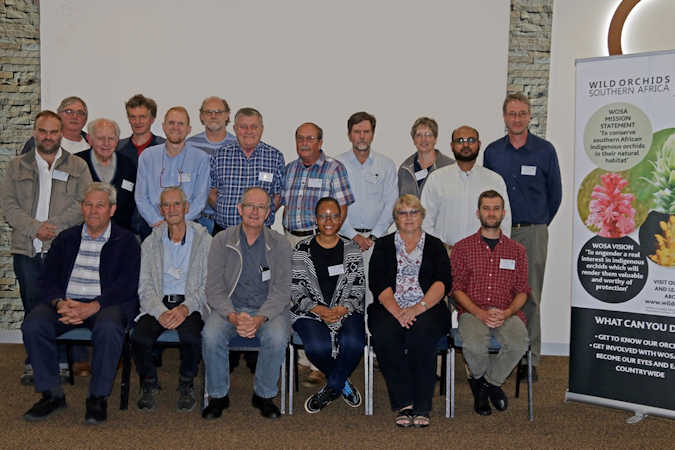
Richard Braby(Speaker), Prof. Steve Johnson(Speaker), Marinus Kort(Audiovisual)
Prof. Craig Peter(Speaker), Gerrit van Ede(Speaker) Andrew Hankey(Speaker), Peter Ashton(Speaker), Martin Rautenbach(Speaker), Erhard Schmid(Registrar), Jane Kratz(Delegate), Tanay Bose(Speaker), Karsten Wodrich(President)
Christo Page(Session Chairman), Jim Holmes(Speaker), Jimmy Pauck(Conference Host), Modjadji Makwela(Speaker), Prof. Joanna Dames(Speaker), Dean Phillips(Speaker)
Index
- Opening address
- Where has all the pollen gone, towards a better understanding of pollen fates in orchid populations
- Cultivating African terrestrial orchids
- A systematic revision of the genus Stenoglottis
- The genus Polystachya in South Africa
- A synthesis of the threats to and conservation status of South African Orchids
- Orchids of the KwaZulu Natal South coast Mtumvuma Reserve/Gorge
- Are some orchid mycorrhizal fungi more casual than others?
- Diversity of Mycorrhiza with endemic South African orchids
- Barcoding of South African orchid mycorrhizae - unravelling the diversity
- Conservation of Habenaria barbertonii and Habenaria kraenzliniana
- Crowdfunding for the Albertina Sisulu Orchid Project
- Orchids of the Southern Drakensberg
- Conference Workshop: WOSA Diaphananthe millarii rescue and re-introduction Project
- Field trips
1. Opening address
WOSA President Karsten Wodrich
 Karsten has been growing orchids since he was 14 when he first found a colony of Eulophia ovalis ssp. bainesii in Robindale, Randburg. Whilst studying to become a Mechanical Engineer at the University of Stellenbosch he published a book entitled Growing South African Indigenous Orchids in 1996. After leaving university Karsten stared both a family and a business, and orchids had to take a back seat. Now that both those undertakings have become firmly established he has returned to his love of orchids and is concentrating on propagating species and hybrids from seed. He is currently President of WOSA.
Karsten has been growing orchids since he was 14 when he first found a colony of Eulophia ovalis ssp. bainesii in Robindale, Randburg. Whilst studying to become a Mechanical Engineer at the University of Stellenbosch he published a book entitled Growing South African Indigenous Orchids in 1996. After leaving university Karsten stared both a family and a business, and orchids had to take a back seat. Now that both those undertakings have become firmly established he has returned to his love of orchids and is concentrating on propagating species and hybrids from seed. He is currently President of WOSA.
Welcome
For those that that are attending the Conference for the first time our vision at Wild Orchids Southern Africa (WOSA) is “to engender a real interest in indigenous orchids which will render them valuable and worthy of protection.” This approach to conservation is significantly different from the fear-based approach which predominated ten years ago which suggested the best way to protect indigenous orchids is to not talk about them at all. Such thinking will not stop developers from bulldozing natural orchid habitats without the necessary Environmental Impact Assessments and permits. Conservation and education are key to the survival of orchids, as is the establishment of Wild Orchid Chapters across the country.
Download the pdf Opening-Address-K_Wodrich-WOSA4-2019
2. Where has all the pollen gone, towards a better understanding of pollen fates in orchid populations
Prof. Steve Johnson
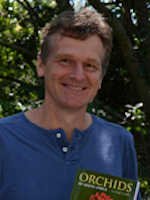 Professor Steven Johnson’s research focuses on pollination biology, evolution, plant speciation, insect-plant relationships, and floral deception and mimicry.
Professor Steven Johnson’s research focuses on pollination biology, evolution, plant speciation, insect-plant relationships, and floral deception and mimicry.
He obtained a B.Sc. (Hons.) and Ph.D. in Botany from the University of Cape Town in 1994. He then worked as a post-doctoral researcher at the University of Haifa in Israel and at Uppsala University in Sweden before moving to UCT where he was a Smuts Post-doctoral Fellow. He is currently a full Professor at the University of KwaZulu-Natal, and holds the DST/NRF South African Research Chair in Evolutionary Biology. During the course of his career he has published or co-published more than 270 peer-reviewed scientific papers and book chapters, as well as four books: Table Mountain: a Natural History (1999), Cape Orchids (2012), Orchids of South Africa (2015) and Floral Mimicry (2017). He has served on the editorial boards of Oecologia, Arthropod-Plant Interactions, and Proceedings of the Royal Society: Biological Sciences and has acted as a reviewer for numerous other journals. He started working at Verloren Vallei in the mid 1990s.
Abstract
The presentation covers all aspects of the transfer of pollen in indigenous orchid populations. These include the methods of pollen transfer, the distance that pollen is transferred, how much pollen actually reached the stigmas of the orchid flowers and how much pollen is involved in self-pollination. This research requires novel ways of data collection such as chemical staining of pollinia.
3. Cultivating African terrestrial orchids
Jim Holmes
 Jim Holmes owner and co-founder of Cape Seed and Bulb Company, studied horticulture and Biology at Guelph University in Ontario, Canada, prior to working at the Glasgow Botanical Gardens where he looked after the orchid house. After extensive overseas experience in terrestrial orchid species (including Disa, Eulophia, Satyrium and Brachychorythis), he eventually settled in Stellenbosch where he worked at the Barlows' Rustenburg Estates. In 1978 he started his own business where hsi main focus has been on African Bulbs and orchids.
Jim Holmes owner and co-founder of Cape Seed and Bulb Company, studied horticulture and Biology at Guelph University in Ontario, Canada, prior to working at the Glasgow Botanical Gardens where he looked after the orchid house. After extensive overseas experience in terrestrial orchid species (including Disa, Eulophia, Satyrium and Brachychorythis), he eventually settled in Stellenbosch where he worked at the Barlows' Rustenburg Estates. In 1978 he started his own business where hsi main focus has been on African Bulbs and orchids.
Abstract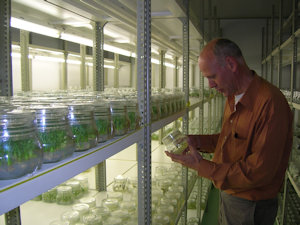
One can categorize orchids into 2 basic groups, epiphytic and terrestrial.The epiphytic species are widely grown, with their tough phylogne roots, which anchor the plants to the trees and branches and absorb water and nutrients, and free air movement. Most of these if grown under right conditions, will thrive, are easily propagated from seed as their germination nutrient solutions have been developed. This is not true for the terrestrials, with their soft tuberoids and delicate roots covered in fine root hairs adopted to grow in soil, or compost growing medium where the watering and growing medium is crucial for good results. Seed germination is problematic for most terrestrial species as the correct germination nutrient solutions have yet to be developed. They are generally seen by most orchid people as too difficult to grow and so are neglected. With the vast devastation of the natural environment, many of these terrestrial species are in danger of becoming extinct, and serious attempts need to be made to prevent this from happening. Cultivation may play a very important role here.
4. A systematic review of the genus Stenoglottis
Dean Phillips

Abstract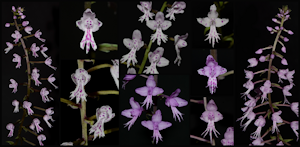
Stenoglottis Lindl. (Orchidaceae) is a small genus of orchids native to forests of Southern and East Africa. While the genus itself is unquestionably monophyletic, species delimitations remain unresolved. Previous taxonomic treatments have recognized between four and nine poorly circumscribed taxa, some of which are rare and locally restricted. Inaccurate species delimitations are of concern and may hamper effective conservation measures. We investigated taxon boundaries by means of a combined morphological and molecular phylogenetic approach, The results do not support the current delimitation of Stenoglottis taxa and, consequently, a new taxonomic treatment is proposed.
5. The genus Polystachya in South Africa
Dr. Peter Ashton
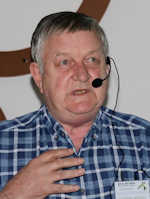 My love for orchids started in high school when I bought my first plant, which, I am pleased to say, is still alive. I matriculated from an Agricultural high school, studied horticulture at the Pretoria Technikon and received my B-Tech degree in 2007. After being employed as a senior horticulturist for some years, I eventually decided it was time to do my own thing. Together with Nollie Cilliers, we started Plantae Orchids, an orchid and rare plant nursery. We strive to supply the local market with the latest hybrids and also sought-after species. As a member the Orchid Society of Northern Transvaal, I soon realized I wanted to become an orchid judge. I qualified in 2008 as a judge with the South African Orchid Council and currently serve on the SAOC board as president. I was the show chairman of the 15th National SAOC Orchid Show hosted by the Rustenburg Orchid Society which is now my home society. September 2013 saw the release of ‘Anyone can grow orchids’ - a book authored by Nollie Cilliers and myself. We expect it to act as a guide for South African orchid growers and gardeners. This book as well as talks at orchid societies, garden clubs and conferences is my way of sharing a love for orchids with like- minded people. I love seeing orchids grow in nature and we take every available opportunity to go and search for orchids in the natural habitat.
My love for orchids started in high school when I bought my first plant, which, I am pleased to say, is still alive. I matriculated from an Agricultural high school, studied horticulture at the Pretoria Technikon and received my B-Tech degree in 2007. After being employed as a senior horticulturist for some years, I eventually decided it was time to do my own thing. Together with Nollie Cilliers, we started Plantae Orchids, an orchid and rare plant nursery. We strive to supply the local market with the latest hybrids and also sought-after species. As a member the Orchid Society of Northern Transvaal, I soon realized I wanted to become an orchid judge. I qualified in 2008 as a judge with the South African Orchid Council and currently serve on the SAOC board as president. I was the show chairman of the 15th National SAOC Orchid Show hosted by the Rustenburg Orchid Society which is now my home society. September 2013 saw the release of ‘Anyone can grow orchids’ - a book authored by Nollie Cilliers and myself. We expect it to act as a guide for South African orchid growers and gardeners. This book as well as talks at orchid societies, garden clubs and conferences is my way of sharing a love for orchids with like- minded people. I love seeing orchids grow in nature and we take every available opportunity to go and search for orchids in the natural habitat.
Abstract
Eleven species of Polystachya plus one natural hybrid have been confirmed to occur in South Africa; this is equivalent to 21% of all the epiphytic orchid species that have been recorded in the country. Another species, P. zambesiaca, is also probably present in the Limpopo Province of South Africa (Stewart et al., 1982), but this must still be confirmed because the evidence provided is insufficient. Most Polystachya species in South Africa occur in small pockets of suitable habitat that span a wide altitudinal range from the Western Cape eastwards along the coastal and mountainous areas, and then northwards to Limpopo Province. Five of the Polystachya species and the one natural hybrid are endemic to South Africa and Swaziland.
Download the full paper The-genus-Polystachya-in-South-Africa-P_J_Ashton-WOSA4-2019.pdf
6. A synthesis of the threats to and conservation status of South African Orchids
Prof Craig Peter
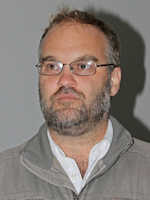 Prof Craig Peter is Associate Professor at the Department of Botany at Rhodes University. He is interested in a broad range of ecological and evolutionary questions associated with plant pollination biology. Craig is currently undertaking the pollination biology studies on the critically endangered orchid Brachycorythis conica subsp. transvaalensis.
Prof Craig Peter is Associate Professor at the Department of Botany at Rhodes University. He is interested in a broad range of ecological and evolutionary questions associated with plant pollination biology. Craig is currently undertaking the pollination biology studies on the critically endangered orchid Brachycorythis conica subsp. transvaalensis.
Abstract
Globally, orchids include some of the most threatened plant species and the entire family is listed as CITES appendix 2 reflecting the breadth of these threats as well as the challenges of mitigating them. The large number of threats are likely a consequence of both narrow habitat requirements of many orchids as well as their specialized biotic interactions. The southern African orchid flora includes 481 species (509 taxa: species, subspecies and varieties, but excluding hybrids), across 54 genera but 75% of these species belong to just 11 genera. Of the 509 unique taxa, 334 (66%) are endemic to South Africa, Lesotho and Swaziland. The vast majority of these taxa have been screened by the SANBI red listing efforts. Analyzing these data reveals that 88 taxa (17%) are of conservation concern (EX, CR PE, CR, EN, VU or NT) and a further 42 (8%) are naturally rare but are not currently threatened. Of the 334 endemic taxa, 80 (24%) are of conservation concern and all but one of the naturally rare taxa are endemic. Forty percent of the threatened taxa occur in the summer rainfall areas while sixty percent occur in the winter rainfall areas. Only 49 taxa are found in both summer and winter rainfall areas and two of these are considered vulnerable. Individual red list species assessments include descriptions of threats. The most frequently implicated threats include invasion by alien vegetation (24% of cases), urban development (19%), Agriculture (15%), overgrazing and trampling (7%), fire mismanagement (6%), collection and flower picking (5%), forestry (4%), mining (3%) and pollinator loss (3%) among numerous others (e.g. medicinal collection, infrastructure development, eutrophication and pollution, erosion and fragmentation). Thanks to SANBI’s efforts, South Africa has a comprehensive understanding of the status of our orchids and the threats that they face. Further work should leverage this foundational knowledge to prioritize both research and conservation efforts.
7. Orchids of the KwaZulu Natal South coast Mtumvuma Reserve/Gorge
Martin Rautenbach
 Martin Rautenbach spent a lot of his free time hiking in the Magaliesberg before he transferred to the KwaZulu Natal South Coast in 1981. As commanding officer in the Police Station in Weza (against the iNgeli Mountain), he developed an intimate knowledge of this rugged mountain area and its forests. In 1996 he joined the Alfred County Orchid Society where he served on the committee in various positions as well as the president. Marin qualified as a South African Orchid Council judge in 2010 and currently spends his time photographing and recording South African orchid species in Southern KwaZulu Natal. Martin has a keen eye for unusual flower forms and potentially new species.
Martin Rautenbach spent a lot of his free time hiking in the Magaliesberg before he transferred to the KwaZulu Natal South Coast in 1981. As commanding officer in the Police Station in Weza (against the iNgeli Mountain), he developed an intimate knowledge of this rugged mountain area and its forests. In 1996 he joined the Alfred County Orchid Society where he served on the committee in various positions as well as the president. Marin qualified as a South African Orchid Council judge in 2010 and currently spends his time photographing and recording South African orchid species in Southern KwaZulu Natal. Martin has a keen eye for unusual flower forms and potentially new species.
Abstract
Note that there are two different spellings of the name, Mthamvuna, the name of the river that forms the boundary between the Eastern Cape and Kwa-Zulu Natal, and Umtamvuna, the name of the Nature Reserve that is situated on the Northern bank of the Mthamvuna River’s lower side.
The Mthamvuna River has its headwaters in the I’Ngeli Mountain on the eastern side of Kokstad in the Midlands. The river winds its way east, and at a point about two thirds on its way to the Indian Ocean, it breaches a way through one of the oldest geological formations in Kwa-Zulu Natal, called the Pando Land System, a slightly younger formation but still part of the Natal System. It is a rugged, broken up area of sandstone plato’s and steep and deep gorges, yet breathtakingly beautiful, with beautiful flora that includes many species of orchids, some that can only be found in this area. The grassy slopes and plato’s incorporates several wetlands, damp and dry grasslands with lots and lots of terrestrial orchid species, the steep slopes in the Mthamvuna River Gorge are densely forested, with Epiphytic and Lithophetic orchids to be found everywhere.
The Mthamvuna River emerges out of The Gorge at Port Edward where on its north bank has another small conservation area known as the Red Desert, the sight of many rare orchids and some that is outright enigmatic in comparison with some closely related species. This area will form a portion of the presentation at the Terrestrial Orchid Conference in the Drakensberg.
8. Are some orchid mycorrhizal fungi more casual than others?
Prof. Joanna Dames
 Prof Joanna Dames is a Microbiologist/Mycologist and completed her BSc and BSc Honours degrees at the University of KwaZulu-Natal in Pietermaritzburg. After some work experience she obtained her MSc and PhD degrees from the University of the Witwatersrand where she also worked as a Research Assistance and Technical Officer in Biochemistry. Prof Dames joined Rhodes University in 1997 as a lecturer and was Head of the Department of Biochemistry and Microbiology for over 7 years. She is currently Deputy Dean of Science, lectures in Microbiology and runs an active Mycorrhizal Research group. She has graduated 46 postgraduate students at all levels, and is an NRF C2 rated scientist. She shares her passion for mycorrhizal fungi through public talks and articles.
Prof Joanna Dames is a Microbiologist/Mycologist and completed her BSc and BSc Honours degrees at the University of KwaZulu-Natal in Pietermaritzburg. After some work experience she obtained her MSc and PhD degrees from the University of the Witwatersrand where she also worked as a Research Assistance and Technical Officer in Biochemistry. Prof Dames joined Rhodes University in 1997 as a lecturer and was Head of the Department of Biochemistry and Microbiology for over 7 years. She is currently Deputy Dean of Science, lectures in Microbiology and runs an active Mycorrhizal Research group. She has graduated 46 postgraduate students at all levels, and is an NRF C2 rated scientist. She shares her passion for mycorrhizal fungi through public talks and articles.
Abstract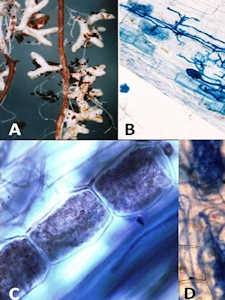
Orchids are associated with fungi, mainly from the Basidiomycota phylum forming unique mycorrhizal associations. The fungal associates of South African orchids are largely unknown and recent research on several orchid species occurring in the Eastern Cape have indicated some unexpected fungal partners such as Xylaria, Psathyrella, Oidiodendron. Several of these fungi are known to associate with other mycorrhizal host plants forming different mycorrhiza associations when considering morphological interactions with root cells. Other fungi are more saprotrohic. These more casual associations will be discussed in terms of their biological and ecological potential.
9. Diversity of Mycorrhiza with endemic South African orchids
Modjadji Makwela
 Modjadji Makwela is a student with the University of Pretoria and completed her Bachelor in Sciences in Microbiology at the University of Pretoria in 2016 and has just completed her Honours in Microbiology on the exciting subject of mycorrhiza with her advisor Dr Almuth Hammerbacher and co-advisors Tanay Bose and Prof Brenda Wingfield.
Modjadji Makwela is a student with the University of Pretoria and completed her Bachelor in Sciences in Microbiology at the University of Pretoria in 2016 and has just completed her Honours in Microbiology on the exciting subject of mycorrhiza with her advisor Dr Almuth Hammerbacher and co-advisors Tanay Bose and Prof Brenda Wingfield.
Abstract
The diversity of mycorrhizae associated with orchids is not well documented. In this regard South Africa is not an exception. South Africa harbours over 500 orchid species of which 471 are endemic and largely endangered. Community composition of mycorrhizae associated with these endemic orchids is substantially unknown. The present study aims to determine the community composition of mycorrhizae associated with four endemic terrestrial orchid species in the genera, Habenaria and Brachycorythis. For this, orchids and rhizosphere soil samples were collected from the Walter Sisulu National Botanical Garden and an orchid farm in Gauteng province. Positive mycorrhizal interactions were confirmed using light microscopy of the orchid roots. Mycorrhizal diversity was determined using both culture dependent and high-throughput sequencing platform (HTS). For HTS, environmental DNA (eDNA) was extracted from orchid roots and rhizospheric soil samples, followed by amplification of the eDNA using mycorrhizae specific primers. Amplicons were sequenced using Illumina HiSeq 2500. Results from the present study will provide a substantial list of potential mycorrhizae associated with each of the orchid species and in their rhizospheric soil. In future, this information can be implemented in ex-situ conservation of these orchids.
10. Barcoding of South African orchid mycorrhizae - unravelling the diversity
Tanay Bose
 Tanay Bose completed his Bachelor in Sciences and Master of Sciences in Botany in Calcutta in 2007 and then specialized in the taxonomy and molecular Systematics of Fungi – completing his Doctorate in Microbiology with the University of Pretoria.
Tanay Bose completed his Bachelor in Sciences and Master of Sciences in Botany in Calcutta in 2007 and then specialized in the taxonomy and molecular Systematics of Fungi – completing his Doctorate in Microbiology with the University of Pretoria.
Abstract
The conservation of wild orchids requires the presence of mycorrhizal associations. However, for most South African orchids, these symbionts are not known. To identify the mycorrhizal fungi associated with Habenaria barbertonii both culture dependent and independent approaches were used. DNA extracted directly from orchid roots as well as from fungal cultures was used for DNA barcoding. Results showed that H. barbertonii associates with the mycorrhizal genus Ceratobasidium. A culture of this fungus allows for further research into its effect on orchid seed germination. Future research will deal with the implementation of mycorrhizae in conservation approaches for South African orchids.
11. Conservation of Habenaria barbertonii and Habenaria kraenzliniana
Gerrit van Ede
 Gerrit was born in the Netherlands and came to South Africa with his parents in 1949. He obtained the degrees BSc (Eng) Electrical and a MBA from the University of Pretoria and started growing orchids in 1962 after he collected three orchid species being: Cyrtorchis arcuata, Eulophia speciosa and a Bulbohyllum species. He has served as a judge with the South African Orchid Council for 26 years and was the President of the South African Orchid Council for two non-consecutive terms. His main interest is in African and specifically South African orchids as well as Paphiopedilums. Gerrit was always interested in conservation of orchids and shifted his interest more in this direction after the 1988 SAOC National Orchid Conference and Show. He visited Verloren Valei Nature Reserve in Mpumalanga for the first time in early 1989 and after that, visited the reserve with orchid friends about every three weeks during the orchid growing season for a number of years. He still visits the reserve regularly. Gerrit was chairman of the 21st World Orchid Conference and Show, held in 2014 in Johannesburg and served on the organising committee as well as being the Conference Chairman.
Gerrit was born in the Netherlands and came to South Africa with his parents in 1949. He obtained the degrees BSc (Eng) Electrical and a MBA from the University of Pretoria and started growing orchids in 1962 after he collected three orchid species being: Cyrtorchis arcuata, Eulophia speciosa and a Bulbohyllum species. He has served as a judge with the South African Orchid Council for 26 years and was the President of the South African Orchid Council for two non-consecutive terms. His main interest is in African and specifically South African orchids as well as Paphiopedilums. Gerrit was always interested in conservation of orchids and shifted his interest more in this direction after the 1988 SAOC National Orchid Conference and Show. He visited Verloren Valei Nature Reserve in Mpumalanga for the first time in early 1989 and after that, visited the reserve with orchid friends about every three weeks during the orchid growing season for a number of years. He still visits the reserve regularly. Gerrit was chairman of the 21st World Orchid Conference and Show, held in 2014 in Johannesburg and served on the organising committee as well as being the Conference Chairman.
Abstract
The decline in number of plants of two terrestrial orchid species namely, Habenaria barbertoni and Habenaria kraenzliniana and the stable position of two others Habenaria epipactidea and Bonatea antennifera in the rural area I live in (east of Pretoria), are investigated. The period covered is from 1977 - 2017: That is 40 years. The following changes occurred that may individually or collectively caused the decline. Possibly the most important one is the burning of the veld. Secondly, is alien vegetation and thirdly, indigenous vegetation. Human interference could also be a main cause, but as the decline also occurred on my property and I did my best to maintain the original vegetation on parts of my property on which these plants occurred, I am not listing this as a main cause. Although these changes took place in the whole area as well as on my property, it is of interest that the two species H. epipactidea and B. antennifera were not affected. It is unclear why they remained stable or even increased in number on my property. A disturbing recent trend by some land owners in our area is to cut the veld very short five or six times a year and thereby destroying the biodiversity of large areas of veld.
12. Crowdfunding for the Albertina Sisulu Orchid Project
Andrew Hankey
 Andrew Hankey is a Botanical Horticulturist and works for SANBI at the Walter Sisulu National Botanical Garden where he is the Assistant Curator / Specialist Horticulturist. Andrew and his Proteadal Conservation Association team including Tony de Castro and Belinda Cooper have been instrumental in pushing the conservation of the Albertina Sisulu Orchid into the public space. Andrew rediscovered the orchid in its Krugersdorp location in 2007 and is passionate about the conservation of the ridge area behind the Walter Sisulu Botanical Garden together with its diverse plant and animal life and specifically the Albertina Sisulu Orchid.
Andrew Hankey is a Botanical Horticulturist and works for SANBI at the Walter Sisulu National Botanical Garden where he is the Assistant Curator / Specialist Horticulturist. Andrew and his Proteadal Conservation Association team including Tony de Castro and Belinda Cooper have been instrumental in pushing the conservation of the Albertina Sisulu Orchid into the public space. Andrew rediscovered the orchid in its Krugersdorp location in 2007 and is passionate about the conservation of the ridge area behind the Walter Sisulu Botanical Garden together with its diverse plant and animal life and specifically the Albertina Sisulu Orchid.
Abstract
A crowdfunding project was conducted by the Sugarbush Ridges Coalition as an experimental exercise to assess whether this model would be effective as a method of fundraising for purposes of conservation. An overview of the process, successes, failures and lessons learned are discussed.
Download the full paper Crowdfunding-as-a-funding-model-for-conservation-A_Hankey-WOSA4-2019.pdf
13. Orchids of the Southern Drakensberg
Richard Braby
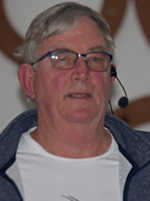 Julie & Richard Braby have had a holiday cottage in the Drakensberg since 1986. Their interest in orchids started around the time when they moved into this area permanently in 2006.
Julie & Richard Braby have had a holiday cottage in the Drakensberg since 1986. Their interest in orchids started around the time when they moved into this area permanently in 2006.
Since then most of their free time during the orchid season is used searching for new species that they have not seen before. A lot of the time was spent in the KZN wildlife area at Garden Castle.
Richard is about to publish a book entitled 'Wild Orchid of the Southern Drakenberg'.
It has taken 12 years to complete and Julie has said it would have been published posthumously if were not for the Orchid Conference spurring him on to complete it.
The book will be available from March or April 2019 onwards.
Abstract
This is a photographic representation of the Orchids found in the 30km band from Ramatsoliso’s Gate to Loteni Nature Reserve. Julie and I are fortunate that we share the same passion for the mountains. I enjoy photography and Julie is interested in the flora so we combined our interest and almost every weekend we headed into the hills. My original objective was to produce a book on all the flowers in our area however this soon proved to be an overwhelming task . The field was narrowed down to orchids which as it turned out was not as easy as I expected. 12 years later the format of the book changed from a simple coffee table book with pretty pictures to a far more serious study of the plants. The intention of this book is to help orchid enthusiasts to identify orchids without having to have much botanical knowledge. The book is largely pictorial showing differences between similar species with illustrations. The purest will probably dispute the accuracy of this method however I am certain satisfactory results will be achieved. As the incorrect identification is not life threatening the simplified process will do no real harm but will certainly allow the reader to make the task a lot less daunting. If a hundred percent accuracy is required there are several references books available which are very useful but frustrating if you are not a trained botanist.
14. Workshops
WORKSHOP 1
Facilitator Prof Craig Peter
WOSA Rhipidoglossum millarii rescue and re-introduction Project
Sunday morning kicked off with a discussion and the formulation of the plan around the that Prof. Craig Peter had secured for sowing seed of Rhipidoglossum (formerly Diaphananthe) millari. The idea is to re-introduce plants not only into the original locations where they have been stripped by muthi collectors but possibly also introduce them into trees on private property and municipal trees.
15. Field trips
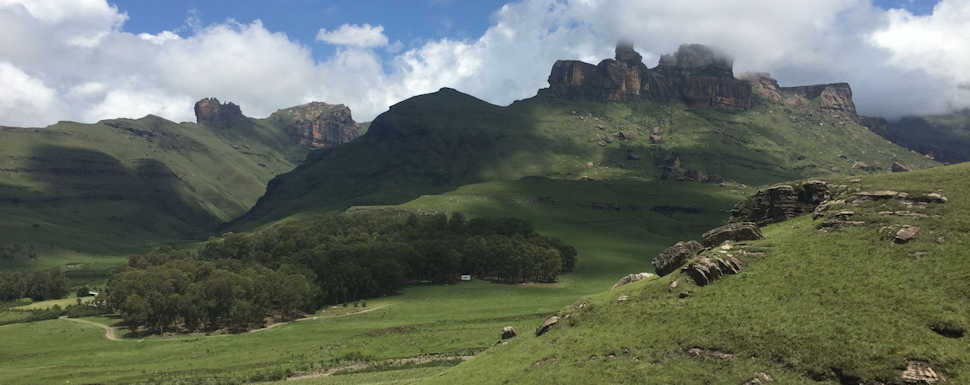
The venue was selected to give delegates the opportunity to see the indigenous orchids of the southern Drakensberg during outings on the Friday before and the Sunday after the Conference. More than 21 orchid species were seen on the field trips that were arranged by the KZN CREW teams led by Judy Braby. These trips were designed for those that simply wanted to step out of the vehicles into the orchids to a light amble through the grasslands or the more challenging walks. Delegates were able to choose the walk most suited to their liking. Each group was accompanied by a guide from the local CREW team.
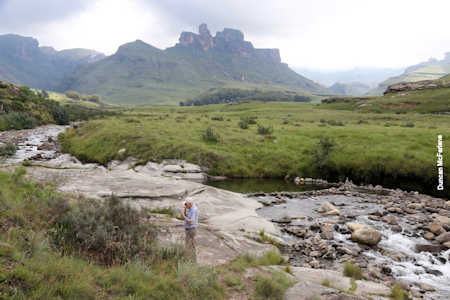 |
 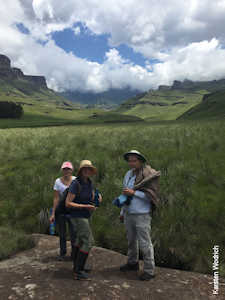  |
Proceedings WOSA 5 Conference 2020
Following are summaries of the talks - as the full length papers are now completed after the conference they will be added with a link below each abstract.
 |
|
Damian Lourens (Speaker), Andrew Hankey (Speaker), Marinus Kort (Vice Chairman & Audiovisual), Gavin McDonald (Speaker), Jimmy Pauck (Speaker), Dr Peter Ashton (Speaker) Karsten Wodrich (President & Speaker), Prof Craig Peter (Speaker), Hendrelien Peters (Speaker), Hildegard Crous (Speaker), Prof Steve Johnson (Speaker) |
Index
- Opening address
- The 'HDC Capers' of the Cape Deciduous Orchids
- The epiphytic orchids from around the source of the Zambezi River
- Preliminary hybridising results within the genus Eulophia
- Newly discovered pollination systems in South African Orchids
- A win for the Albertina Sisulu Orchids
- Mycorrhiza in the genus Mystacidium
- Rhipidoglossum (Diaphananthe) millarii project
- Orchids along the KZN highway verges
- The genus Polystachya and its hybridising potential
- Field trips
1. Opening address
Jimmy Pauck & Karsten Wodrich
Jimmy Pauck opened the Conference with a warm welcome to all delegates and speakers and handed over to Karsten Wodrich for the opening address:
I think it is fair to say that 2019 has been a difficult year – not only did we have upheavals from an economic point of view but in June last year we also lost the founder, stalwart and key executive member of Wild Orchid Southern Africa Bill Mincher. In 2014 Bill brought to life what we can now consider a world class conservation organisation Wild Orchids Southern Africa and he was the driving force behind the organisation right to the end. It has been a difficult seven months since then as the new executive and non-executive committee had to take over the task of organising this conference and coming to grips with the many aspects of what Bill did for WOSA.
Download the pdf Opening-Address-K_Wodrich-WOSA5-2020.pdf
2. The 'HDC Capers' of the Cape Deciduous Orchids
Hildegard Crous
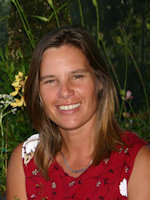 Hildegard Crous won the Kirstenbosch Scholarship in 1990 and this started her long association with South African flora including Disas which she maintained at Kirstenbosch for 10 years before leaving to start her own Disa collection and private laboratory at her home in Barrydale in the Western Cape. She has pioneered new methods for growing Disas, as well as breeding new hybrids, co-authored the book Grow Disas, and is actively involved in the Disa barbata conservation project. Married to Jean Crous, their country lifestyle enables them to enjoy hobbies such as riding, beekeeping, hiking and flying
Hildegard Crous won the Kirstenbosch Scholarship in 1990 and this started her long association with South African flora including Disas which she maintained at Kirstenbosch for 10 years before leaving to start her own Disa collection and private laboratory at her home in Barrydale in the Western Cape. She has pioneered new methods for growing Disas, as well as breeding new hybrids, co-authored the book Grow Disas, and is actively involved in the Disa barbata conservation project. Married to Jean Crous, their country lifestyle enables them to enjoy hobbies such as riding, beekeeping, hiking and flying
Abstract
Little is known about the lifestyle of Cape Deciduous Orchids. The "questionable activities" of these orchids necessitate a different approach for successful cultivation. HDC - Horticulturally Defined Categories - is a "new" classification description assisting in the cultivation of the Cape Deciduous Orchids.
3. Epiphytic Orchids from around the source of the Zambezi River
Dr. Peter Ashton
 Dr Peter Ashton retired from the CSIR after over 36 years working as an Aquatic Ecologist. During this time his career has enabled him to visit 42 of the 48 mainland African countries. His special interest are the epiphytic orchids of Africa.
Dr Peter Ashton retired from the CSIR after over 36 years working as an Aquatic Ecologist. During this time his career has enabled him to visit 42 of the 48 mainland African countries. His special interest are the epiphytic orchids of Africa.
Abstract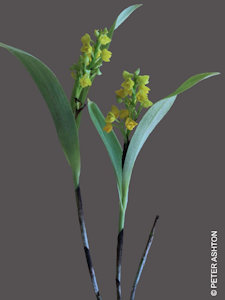
The area around the source of the Zambezi River in north-western Zambia has a rich diversity of epiphytic orchids, with 69 species recorded to date, six of which are endemic to this area of Zambia. Two additional species, representing new records for the Flora Zambesiaca area, were discovered during personal surveys of the dense Miombo woodland of this portion of the country. Further detailed orchid surveys are needed across this remote area and these will likely reveal new and exciting finds!
4. Preliminary hybridising results within the genus Eulophia
Karsten Wodrich
 Karsten has been growing orchids since he was 14 when he first found a colony of Eulophia ovalis ssp. bainesii in Robindale, Randburg. Whilst studying to become a Mechanical Engineer at the University of Stellenbosch he published a book entitled Growing South African Indigenous Orchids in 1996. After leaving university Karsten started both a family and a business, and orchids had to take a back seat. Now that both those undertakings have become firmly established he has returned to his love of orchids and is concentrating on propagating species and hybrids from seed. He is currently President of WOSA.
Karsten has been growing orchids since he was 14 when he first found a colony of Eulophia ovalis ssp. bainesii in Robindale, Randburg. Whilst studying to become a Mechanical Engineer at the University of Stellenbosch he published a book entitled Growing South African Indigenous Orchids in 1996. After leaving university Karsten started both a family and a business, and orchids had to take a back seat. Now that both those undertakings have become firmly established he has returned to his love of orchids and is concentrating on propagating species and hybrids from seed. He is currently President of WOSA.
Abstract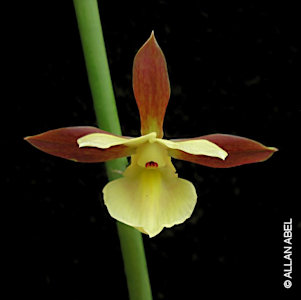
A few hybrids within the genus Eulophia have been registered since 1992 with many more expected to be registered in the not too distant future. Indications are that most of species within the genus Eulophia can be readily crossed. Limited success has been achieved with hybrids between Eulophia and Orthochilus. There are now clear indications of how certain traits are inherited and which parents are preferred in a hybridising programme to improve plant vigour and make them less difficult to grow. Ultimately Eulophia hybrid availability should reduce pressure on natural populations.
5. Newly discovered pollination systems in South African Orchids
Prof Steve Johnson
 Professor Steve Johnson’s research focuses on pollination biology, evolution, plant speciation, insect-plant relationships, and floral deception and mimicry.
Professor Steve Johnson’s research focuses on pollination biology, evolution, plant speciation, insect-plant relationships, and floral deception and mimicry.
He obtained a B.Sc. (Hons.) and Ph.D. in Botany from the University of Cape Town in 1994. He then worked as a post-doctoral researcher at the University of Haifa in Israel and at Uppsala University in Sweden before moving to UCT where he was a Smuts Post-doctoral Fellow. He is currently a full Professor at the University of KwaZulu-Natal, and holds the DST/NRF South African Research Chair in Evolutionary Biology. During the course of his career he has published or co-published more than 270 peer-reviewed scientific papers and book chapters, as well as four books: Table Mountain: a Natural History (1999), Cape Orchids (2012), Orchids of South Africa (2015) and Floral Mimicry (2017). He has served on the editorial boards of Oecologia, Arthropod-Plant Interactions, and Proceedings of the Royal Society: Biological Sciences and has acted as a reviewer for numerous other journals. He started working at Verloren Vallei in the mid 1990s.
Abstract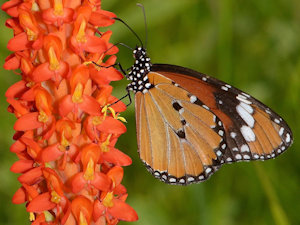
Steve explored the question of why pollination research was vital to understanding evolution, the ecology and the process of natural hybridisation of orchids with specific examples how how precise and complex some of these pollinating mechanism of our indigenous orchids are.
He then proceeded to present his latest, cutting edge and ground breaking research on the pollination of the rare Disa forficaria which was recently rediscovered in the Overberg area in the Western Cape. Work was done on a single flowering plant that flowered only for two seasons. Delegates were blown away by the spectacular photography, the research methodology and the results and we eagerly await the publication of this research.
6. A win for the Albertina Sisulu Orchid
Andrew Hankey & Belinda Cooper
 Andrew is a Botanical Horticulturist and works for the South African National Biodiversity Institute at the Walter Sisulu National Botanical Garden where he is the Assistant Curator / Specialist Horticulturist. His principal duty is the overall co-ordination of entire Botanical Garden Operations and all that this entails.
Andrew is a Botanical Horticulturist and works for the South African National Biodiversity Institute at the Walter Sisulu National Botanical Garden where he is the Assistant Curator / Specialist Horticulturist. His principal duty is the overall co-ordination of entire Botanical Garden Operations and all that this entails.
Andrew and the Proteadal Conservation Association team including chairperson Belinda Cooper and Tony de Castro have been instrumental in pushing the conservation of the Albertina Sisulu Orchid into the public space.
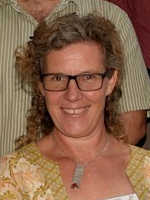 In 2015 Belinda completed her Masters in Environmental Management.Her thesis focused on environmental threats and conservation opportunities in the Magaliesberg Biosphere.
In 2015 Belinda completed her Masters in Environmental Management.Her thesis focused on environmental threats and conservation opportunities in the Magaliesberg Biosphere.
She joined the Magaliesberg Biosphere initiative group in 2012, where she assisted in defining the Biosphere boundaries for UNESCO approval. Once the biosphere was designated in 2015, she helped to negotiate and organise the election of the biosphere management board. During this time she also represented MBIG on the National Man and Biosphere committee.
She feels this exposure has provided her with skills to support effective community based environmental action, which is her current interest and focus as chairperson of the Proteadal Conservation Association. The PCA was formed in response to ever encroaching unsustainable urban development on the West Rand Ridges of Johannesburg.
In her other life, Belinda runs her own business, procuring, designing and selling contemporary ethnic jewellery in the tourist retail sector.
Belinda Cooper is currently the chairperson of the Proteadal Conservation Association.
Abstract
The conservation of the unprotected and largely unfenced areas where the Albertina Sisulu Orchid occurs would quickly become degraded due to increased pressure from the rapidly urbanisaton. The Proteadal Conservation Association (PCA) was formed in 2012 for the purposes of protecting the remaining ridge habitats in which the orchid is found from being lost to urbanisation. Consequently on the ground, activities have largely fallen on the shoulders of volunteer members of the PCA. One of these major undertakings was the court case against the Record of Decision by the MEC. The decision to grant authorisation for the development of almost 3000 high density residential units on a portion of Mogale City property known as Proteadal, was set aside and made an order of the South Gauteng High Court on 31st July 2019. Andrew will give us a detail account of the monumental task of taking the MEC to court and give insight into how this battle was fought.
7. Mycorrhiza in the genus Mystacidium
Damian Lourens
 Damian is a final year MSc Biological Sciences student at Rhodes University under guidance of Prof Joanna Dames and Prof Craig Peter. His master dissertation focuses on the variety of mycorrhizal fungi found in various life stages of the epiphytic orchid genus Mystacidium and analyses the potential role these fungi might play.
Damian is a final year MSc Biological Sciences student at Rhodes University under guidance of Prof Joanna Dames and Prof Craig Peter. His master dissertation focuses on the variety of mycorrhizal fungi found in various life stages of the epiphytic orchid genus Mystacidium and analyses the potential role these fungi might play.
Abstract
Because epiphytic orchids often face extreme conditions in tree canopies it is believed they have a strong dependence on mycorrhizal fungi throughout their life cycle, especially throughout the protocorm stage. This presentation analyses the various life stages of an epiphytic orchid, including protocorm, juvenile and adult stage, for mycorrhizal fungi and other potential mycobionts, and assess the diversity found in each stage of various species in the epiphytic orchid genus Mystacidium.
8. Rhipidoglossum (Diaphanthe) millarii project
Jimmy Pauck & Craig Peter
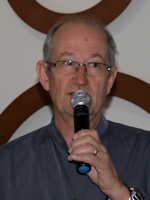 Jimmy is President of the Highway Orchid Society (formerly known as the Queensburgh Orchid Club), and has been growing orchids for over 30 years. He is senior lecturer at the Durban University of Technology in the Chemical Engineering Department, and specialises in pulp and paper technology. Jimmy has a broad range of interests in the natural world, but has a particular passion for conserving orchids.
Jimmy is President of the Highway Orchid Society (formerly known as the Queensburgh Orchid Club), and has been growing orchids for over 30 years. He is senior lecturer at the Durban University of Technology in the Chemical Engineering Department, and specialises in pulp and paper technology. Jimmy has a broad range of interests in the natural world, but has a particular passion for conserving orchids.
 Prof Craig Peter is Associate Professor at the Department of Botany at Rhodes University. He is interested in a broad range of ecological and evolutionary questions associated with plant pollination biology. Craig is currently undertaking the pollination biology studies on the critically endangered orchid Brachycorythis conica subsp. transvaalensis and has proposed a seed propagation project for Rhipidoglossum millarii.
Prof Craig Peter is Associate Professor at the Department of Botany at Rhodes University. He is interested in a broad range of ecological and evolutionary questions associated with plant pollination biology. Craig is currently undertaking the pollination biology studies on the critically endangered orchid Brachycorythis conica subsp. transvaalensis and has proposed a seed propagation project for Rhipidoglossum millarii.
Abstract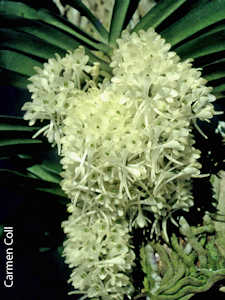
Prof Craig Peter has secured limited funding for the propagation of Rhipidoglossum millarii from the World Orchid Conference 23 team as part of their orchid conservation programme. This project now needs to be implemented but that is not a simple as it seems. Together with the KZN WOSA team led by Jimmy Pauck the project is just getting off the ground and both Jimmy and Craig expanded on the project in their presentation.
9. Orchids of the Greater Durban Highway Area
Hendrelien Peters
 Hendrelien Peters originally qualified as a History, Geography and Physical Education teacher and has been growing orchids since 1982. She is a qualified South African Orchid Council judge. Hendrelien currently curates the orchid collection at the Durban Botanical Gardens and is the editor of Orchids South Africa. Her hobbies include photography and art.
Hendrelien Peters originally qualified as a History, Geography and Physical Education teacher and has been growing orchids since 1982. She is a qualified South African Orchid Council judge. Hendrelien currently curates the orchid collection at the Durban Botanical Gardens and is the editor of Orchids South Africa. Her hobbies include photography and art.
Abstract
Hendrelien took delegates through the unique habitat and show the orchids that are found around the KZN's highways. Many orchids can be found around the KZN highways and the species found in these areas are linked to the elevation as temperatures tend to decrease at night the higher the altitude.
10. The genus Polystachya and its hybridising potential
Gavin McDonald
 Gavin McDonald has been growing orchids for over 30 years and maintains a mixed collection of species and hybrids from a wide range of genera. He is an accredited South African Orchid Council judge and an official Botanist to the South African Orchid Council. Gavin is Assistant Professor and Acting Head of the Department of Nature Conservation at the Mangosuthu University of Technology and has studied indigenous orchids as part of his research interest. This has led to the authoring and co-authoring of a number of new species within the Orchid family.
Gavin McDonald has been growing orchids for over 30 years and maintains a mixed collection of species and hybrids from a wide range of genera. He is an accredited South African Orchid Council judge and an official Botanist to the South African Orchid Council. Gavin is Assistant Professor and Acting Head of the Department of Nature Conservation at the Mangosuthu University of Technology and has studied indigenous orchids as part of his research interest. This has led to the authoring and co-authoring of a number of new species within the Orchid family.
Abstract
Gavin will take a look at the variable epiphytic genus Polystachya, represented by 11 species in South Africa. From a hybridising point of view results have been less spectacular than expected but continued perseverance with hybridising - in particuar by the Duckitts in Darling has now started to bear fruit. Once again by making hybrids available to the public - collecting pressure on species in the wild has been reduced.
11. Field trips

The field trips were scheduled for Friday afternoon 24 January 13:30-17:00 and Saturday morning 25 January 9:00-12:00 in order to ensure that at least the outing on Saturday was not potentially rained out by the typical afternoon thunderstorms that are encountered in the Berg.
The first outing resulted in 16 species being found in close vicinity the parking area. After a short rain storm the outings resumed in two groups. Amongst these were species such as Disa oreophylla ssp. oreophylla growing along the steep banks next to the river. Most of the species observed were close to the car parking area which literally allows one to step out of the car right into the orchids. For the more adventurous there are slightly longer (but still easy) walks as well as a few more strenuous ones were available.
Species seen on the outings were amongst others:
Corycium dracomontanum
Corycium nigresens
Disa oreophylla ssp. oreophylla
Disa versicolor
Disa stachyoides
Eulophia ovalis ssp. bainesii
Eulophia zeheriana
Habenaria dives
Habenaria laevigata
Neobolusia tysonnii
Pterygodium magnum
Satyrium cristatum var. cristatum
Satyrium longicauda
Satyrium microrrhynchum
Satyrium parviflorum
Schizochilus flexuous
THEME - ' INDIGENOUS
ORCHIDS IN A CHANGING LANDSCAPE '
The Conference will take place at the Dunkeld
Estate, Dullstroom, Mpumalanga on 23-25 January 2026.The programme includes pre- and post-conference
Field Trips on Friday and Sunday and a full day Conference Programme on
Saturday covering many interesting topics.
Register now limited seats
WOSA 26 Registration Form
Email This email address is being protected from spambots. You need JavaScript enabled to view it. for further information.
Proceedings WOSA 1 Conference 2016
Ever wondered what pollinates the night scented Mystacidiums? South Africa has seven species of the epiphytic (growing on trees) Mystacidium. Some are green and some are white flowered. In their paper on page 79, Nic Venter and Prof Craig Peter explain why different moths pollinate the beautiful orchids with some spectacular photographs of the moths in action. Using state of the art, movement triggered night cameras the secret of the moth pollination is unravelled. Download the
complete proceedings of the WOSA 1 Conference held in Dullstroom in January 2016 and find valuable information and spectacular photos in 11 additional articles and 4 workshop summaries. Register for the WOSA 2017 conference from 20-22 January 2017 and “Get to know our orchids” - next year’s conference theme!


Proceedings WOSA 1 Conference 2016 PDF Download
WOSA 2016 Conference
The role of Civil Society in Orchid Conservation
The role of Civil Society in Orchid Conservation was the theme of the first Wild Orchids Southern Africa (WOSA) Conference held in Dullstroom on 30 January 2016. Feedback from delegates indicated that the conference was an overwhelming success, with most coming away: more aware of the real value of our indigenous orchids, having gained an understanding why they are worthy of protection and enthusiastic about getting practically involved in making a difference.
Speakers and leader group. Back row left to right. Lourens Grobler, Jane Kratz- Comms. , Kay Montgomery, Nic Venter, Marinus Kort - projection organiser, Andrew Hankey, Dr. Peter Ashton, Prof Craig Peter, Patrick Mannens.
Seated left to righ Karsten Wodrich- Deputy Chairman, Gerrit van Ede -Tour Leader, Bill Mincher- Chairman, Allan Abel - Committee Member.
Dr. Benny Bytebier not in picture was also a speaker.
Second Wild Orchids Conference
Dullstroom
Theme - 'Getting to know our orchids'

At the time of writing it is July 2016 and we have just passed the middle of winter. We have posted the WOSA 1 Conference proceedings on our website - wildorchids.co.za - under the heading 'Conferences',which make excellent reading and is a permanent record for researchers in the future. The conference turned out to be a grand affair with a number of exciting presentations and workshops. We have announced the dates for the WOSA 2 Conference and are arranging another interesting programme for delegates.
The WOSA website has been redesigned to make navigation easier and we are making a concerted effort to get all Provinces functioning which will enhance our footprint and activities. Jimmy Pauck is organizing KZN and Frans Waanders, Northwest Province with the Western Cape being handled by Greg Brill and Jim Holmes. Gerrit van Ede has completed the Flowers of Verloren Valei Field Guide which is a welcome addition to the promotion of indigenous orchids in South Africa. This will add a lot of interest and assist visitors during our field trips in January. We are also planning another 10 guided trips this summer.
Verloren Valei has a dedicated Friends group which is making a difference in its functioning and operation. They enjoy a section on our website under Conservation and are looking for members who wish to support them in the development of the Reserve.
The Gallery on the website has proved popular with over 14000 hits which consists of roughly 50% new visits and the same number of return visits. Gerrit is busy with providing the description of the orchids and Duncan McFarlane with populating the orchid photographs. To my knowledge this is the only electronic representation of indigenous orchids which perhaps explains its popularity.
The Conference will take place at the Dunkeld Country Estate on the Tonteldoos road, Dullstroom, 20 - 22 January 2017
Programme includes two Field Trips to Verloren Valei and a full conference programme covering topics such as ' South African orchids and the ' muti ' trade, and many more interesting topics.
Result of Field Trips during 2nd Conference 2017
Dullstroom
20th and 22nd January 2017

Orchid Hunting on the White Ridge
Notes:
1. Morphologically this cross appears to be between Disa versicolor and Disa rhodantha.
2. The McMurtry et al concept of Eulophia hians "aestivalis" form and Eulophia hians var. nutans is difficult to distinguish at this time of the year. Normally the "aestivalis" form on Verloren Valei flowers earlier and the spikes are short. I decided the plant my group saw was rather E. hians var. nutans, although the colour pointed to the "aestivalis form". Johnson et al would consider the plant as E. hians var. nutans.
Factors affecting flowering of the terrestrial orchids
A number of factors may influence whether a terrestrial orchid will flower or not.
Fire has been recorded as influencing and, in some cases, to be necessary for the flowering of some terrestrial orchids.
Whether the plant is large enough to flower is another factor.
Soil temperature during summer and winter may influence the initiation of flowers.
The past two seasons are of interest. Researching terrestrial orchids is not that easy. I think we should report what we found so that future researchers may benefit from our observations. The climate in the 2015 - 2016 summer was different from other years in that rainfall was considerably less than the average and summer temperatures were quite a bit higher than normal. I think the winter was also warmer than usual. This information should be available from the Reserve Management. Then in 2016 no blocks were burnt. Only the fire-breaks were burnt. The burning of the fire-breaks can be used to some extent, as control, but unfortunately the burning of the fire-breaks occur too early in the season - late autumn (May) or early winter (beginning June). Burning this time of the year may be detrimental to some, especially, later flowering orchids.
The following remarks are relevant in this context.
3. Disa rhodantha habitat is the edge of streams, marshes and wet grassland. Drought may influence the development of the new tuber. It may be too small to support flowering. I visited a number of the localities of D. rhodantha and found very few plants. As the localities are all wet, the lack of fire this season is most likely the reason why only a few plants flowered. However, two colonies were on a fire-break, but in wet grassland. Those colonies did not flower well. The grassland may have been too dry during the drought, affecting the development of tubers in that season. The warmer winter may also have influenced the initiation of flowering.
4. The Disperis wealei colony was a surprise. With over 30 plants in flower in a small area slightly away from its normal habitat - was really something to see. We did not find plants in flower along the Lunsklip River. This may be due to flooding of the river, which could clearly be seen in the grass along the river.
5. Very few of these two species - Satyrium hallackii subsp. ocellatum and Satyrium longicauda - were in flower. However, a lot of flower spikes could be seen. The impression however, is that it will be less than in 2016.
6. Schizochilus zeyheri normally grows along watercourses, marshes and seasonally wet grassland. Few flowering plants were seen in its normal habitat. However, we found a colony in a wet part of a fire-break. The colony was flowering well, indicating the importance of fire.
In summary, understanding the flowering of terrestrial orchids is a complex matter. In some cases dependence on fire could be derived and in other cases fire did not play a role in their flowering. Some species were more affected by the previous season's climate than other species, while others showed little effect.
For more information regarding the preservation of South Africa's wild Orchids or if you would like to get involved please email This email address is being protected from spambots. You need JavaScript enabled to view it. or complete this short form Contact Us and we will contact you.
